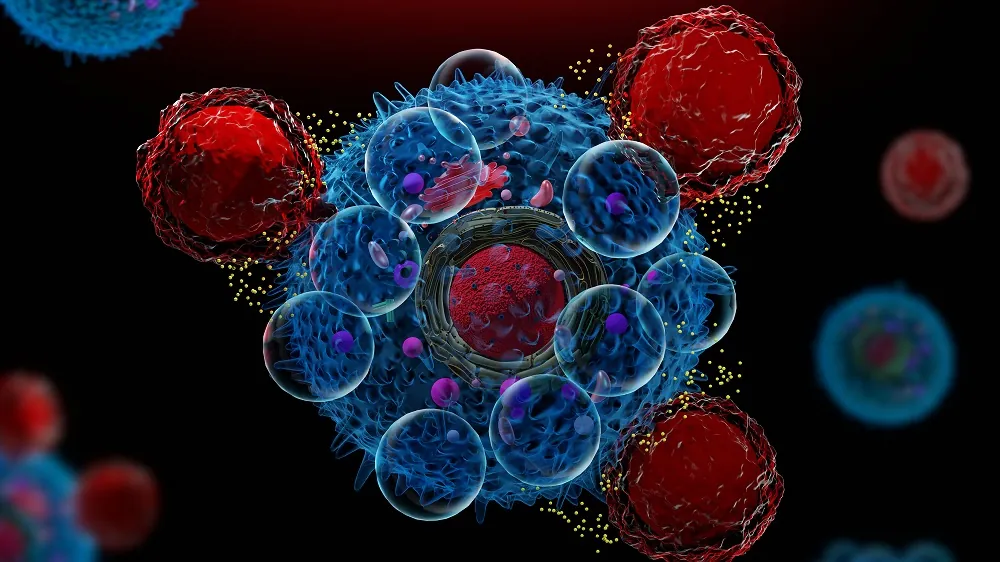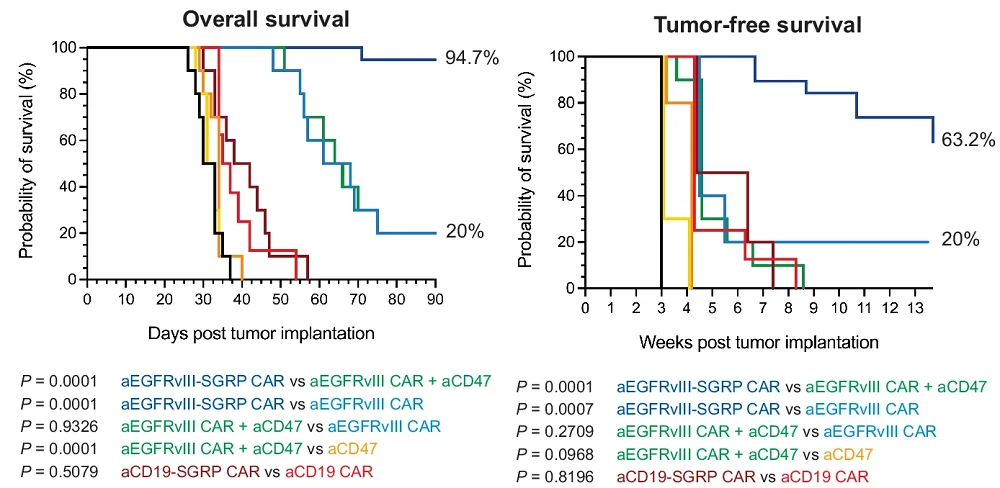Engineering T Cells to Fight Brain Cancer
- These cells directly fight back against the tumor microenvironment.

Researchers publishing in Nature have reported a new advance in developing chimeric antigen receptor (CAR) T cells to fight solid tumors in the brain.
A difficult endeavor
CAR T cell-based therapies are normally discussed in the context of blood cancers, as getting them to effectively attack solid tumors has proven very difficult, despite intensive research on the subject [1]. They have been used to attack glioblastomas, the most aggressive brain tumors in adults [2], even though targeting of antigens associated with this cancer can have toxic, off-target effects [3].
One safer method involves targeting of EGVRvIII, a molecule that appears on roughly 40% of these tumors [4]. However, a clinical trial utilizing this approach failed: the tumors were able to mutate and protect themselves against the treatment [5]. New approaches are being developed, and tested in trials, to better combat these tumors [6].
The researchers note the challenges involved in this sort of work. Glioblastoma tumors are very unfriendly to the immune system, suppressing its functions with increasing severity as the tumor grows [7]. For example, these tumors will secrete CD47, a natural immunosuppressant, in order to prevent macrophages from consuming them [8]. However, targeting CD47 has been found to be ineffective, as the therapy fails to penetrate the tumor, and dangerous to other tissues [9].
These researchers, therefore, have developed a fourth-generation therapy to target these tumors. These anti-EGFRvIII CAR T cells also release SGRP, a protein that binds to CD47, thereby directly fighting the immunosuppressive environment; however, cells also need CD47 to function properly, and the researchers were pleased to note that this alteration did not interfere with the cells’ own function.
Effective in mice
In experiments against cultured glioblastoma cells, which do not have such a protective environment, these new cells performed just as well as other CAR T cells. These cells were also found to be target-specific: cells that do not produce EGVRvIII were not harmed by these engineered cells.
In these sorts of experiments, it is relatively easy to graft human cancer cells into a mouse model and then have the CAR T cells defeat them there; however, this does not sufficiently mimic the actual tumor microenvironment, so preclinical successes can lead to clinical failures. Therefore, the researchers chose a model that avoids this problem.
The previous anti-EGFRvIII therapy was found to be effective in this scenario, extending the tumor-grafted mice’s lives and offering a one-in-five survival rate after 90 days, versus the zero they had with ineffective treatments. However, the new one performed incredibly well in comparison: after 90 days, almost none of the mice had died at all, and about two-thirds of them were completely free of tumors. The systemic toxicity associated with some forms of CAR treatment was not found in the animals treated with the new approach.

Letting other cells do their jobs
The researchers believe that some of the benefits are due to immune cell invasion of the tumors, not just of these particular T cells but of endogenous immune cells of all types. The engineered cells’ expression of SGRP within these tumors appeared to be effective. These findings were further confirmed by an analysis of cellular consumption (phagocytosis). The CAR T SGRP treatment encouraged local cells to do their jobs and consume cancer cells at a higher rate.
Spurred by their findings, the researchers also tested their SGRP approach against a mouse model of lymphoma. While they were not able to obtain the same impressive results as their glioblastoma experiment, they were able to obtain a 20% survival rate after 80 days; none of the animals treated with SGRP-less CAR T cells survived that long. While this approach did not stop lymphoma growth, it greatly slowed it down, even with just one initial treatment.
Despite sharing some of the same qualities, the researchers believe that their approach is superior to previous anti-CD47 approaches because it is expressed consistently and directly into the tumor to which the CAR T cells are attracted, a task that even locally injected antibodies have been found unable to properly do. While this is still just a mouse experiment, it may yield better clinical trial results than previous approaches.
Literature
[1] Hou, A. J., Chen, L. C., & Chen, Y. Y. (2021). Navigating CAR-T cells through the solid-tumour microenvironment. Nature reviews Drug discovery, 20(7), 531-550.
[2] Ostrom, Q. T., Cioffi, G., Gittleman, H., Patil, N., Waite, K., Kruchko, C., & Barnholtz-Sloan, J. S. (2019). CBTRUS statistical report: primary brain and other central nervous system tumors diagnosed in the United States in 2012–2016. Neuro-oncology, 21(Supplement_5), v1-v100.
[3] Luksik, A. S., Yazigi, E., Shah, P., & Jackson, C. M. (2023). CAR T cell therapy in glioblastoma: overcoming challenges related to antigen expression. Cancers, 15(5), 1414.
[4] Felsberg, J., Hentschel, B., Kaulich, K., Gramatzki, D., Zacher, A., Malzkorn, B., … & Weller, M. (2017). Epidermal growth factor receptor variant III (EGFRvIII) positivity in EGFR-amplified glioblastomas: prognostic role and comparison between primary and recurrent tumors. Clinical Cancer Research, 23(22), 6846-6855.
[5] O’Rourke, D. M., Nasrallah, M. P., Desai, A., Melenhorst, J. J., Mansfield, K., Morrissette, J. J., … & Maus, M. V. (2017). A single dose of peripherally infused EGFRvIII-directed CAR T cells mediates antigen loss and induces adaptive resistance in patients with recurrent glioblastoma. Science translational medicine, 9(399), eaaa0984.
[6] Choi, B. D., Gerstner, E. R., Frigault, M. J., Leick, M. B., Mount, C. W., Balaj, L., … & Maus, M. V. (2024). Intraventricular CARv3-TEAM-E T cells in recurrent glioblastoma. New England Journal of Medicine, 390(14), 1290-1298.
[7] Yeo, A. T., Rawal, S., Delcuze, B., Christofides, A., Atayde, A., Strauss, L., … & Charest, A. (2022). Single-cell RNA sequencing reveals evolution of immune landscape during glioblastoma progression. Nature immunology, 23(6), 971-984.
[8] Willingham, S. B., Volkmer, J. P., Gentles, A. J., Sahoo, D., Dalerba, P., Mitra, S. S., … & Weissman, I. L. (2012). The CD47-signal regulatory protein alpha (SIRPa) interaction is a therapeutic target for human solid tumors. Proceedings of the National Academy of Sciences, 109(17), 6662-6667.
[9] Sikic, B. I., Lakhani, N., Patnaik, A., Shah, S. A., Chandana, S. R., Rasco, D., … & Padda, S. K. (2019). First-in-human, first-in-class phase I trial of the anti-CD47 antibody Hu5F9-G4 in patients with advanced cancers. Journal of Clinical Oncology, 37(12), 946-953.







